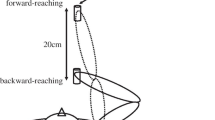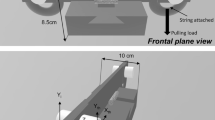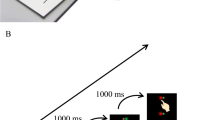Abstract
Older adults adapt the execution of complex motor tasks to use compensatory strategies in the reaching-to-grasping (i.e., prehension) movement. The presence of postural constraints may exacerbate these compensatory strategies. Therefore, we investigated the reach-to-grasp action with different postural constraints (sitting, standing, and walking) in younger and older people and evaluated the postural stability during the reach-to-grasp action. Thirty individuals (15 younger and 15 older adults) performed the prehension under three postural tasks: sitting, standing, and walking. The reaching movement was slower in the walking task than in the other two postural tasks; however, there was no difference between the age groups. For the grasping action, the older adults presented a larger grip aperture, and the peak grip aperture occurred earlier during hand transportation in sitting and standing tasks. In the standing task, the margin of stability was smaller for older adults. In the walking task, there was no difference between the groups for the margin of stability. Also, prehension during sitting and standing tasks were similar, and both differed from walking across age groups. Finally, older adults reduced their margin of stability compared to younger adults, but only in the standing task. The margin of stability was similar between age groups during the walking task. We concluded that age affected grasping (distal component) but not reaching (proximal component), suggesting that healthy older adults have more difficulty controlling distal than proximal body segments.




Similar content being viewed by others
Availability of data and material
The data will be made available upon request.
Code availability
Not applicable.
References
Adamo DE, Martin BJ, Brown SH (2007) Age-related differences in upper limb proprioceptive acuity. Percept Mot Skills 104:1297–1309. https://doi.org/10.2466/pms.104.4.1297-1309
Adamo DE, Alexander NB, Brown SH (2009) The influence of age and physical activity on upper limb proprioceptive ability. J Aging Phys Act 17:272–293. https://doi.org/10.1123/japa.17.3.272
Bellinger GC, Pickett KA, Mason AH (2020) Interlimb coordination during a combined gait and prehension task. Mot Control 24:57–74. https://doi.org/10.1123/mc.2018-0053
Bennett KM, Castiello U (1994) Reach to grasp: changes with age. J Gerontol 49:P1-7. https://doi.org/10.1093/geronj/49.1.p1
Carnahan H, Goodale MA, Marteniuk RG (1993) Grasping versus pointing and the differential use of visual feedback. Hum Mov Sci 12:219–234. https://doi.org/10.1016/0167-9457(93)90016-I
Carnahan H, Mcfadyen BJ, Cockell DL, Halverson AH (1996) The combined control of locomotion and prehension. Neurosci Res Commun 19:91–100. https://doi.org/10.1002/(SICI)1520-6769(199609)19:2%3c91::AID-NRC168%3e3.0.CO;2-X
Carnahan H, Vandervoort AA, Swanson LR (1998) The influence of aging and target motion on the control of prehension. Exp Aging Res 24:289–306. https://doi.org/10.1080/036107398244265
Castiello U (2005) The neuroscience of grasping. Nat Rev Neurosci 6:726–736. https://doi.org/10.1038/nrn1744
Chapman CS, Gallivan JP, Culham JC, Goodale MA (2011) Mental blocks: fMRI reveals top-down modulation of early visual cortex when obstacles interfere with grasp planning. Neuropsychologia 49:1703–1717. https://doi.org/10.1016/j.neuropsychologia.2011.02.048
Cicerale A, Ambron E, Lingnau A, Rumiati RI (2014) A kinematic analysis of age-related changes in grasping to use and grasping to move common objects. Acta Physiol (oxf) 151:134–142. https://doi.org/10.1016/j.actpsy.2014.06.004
Ciolek CH, Lee SY (2020) Cognitive issues in the older adult. In: Avers D, Wong RA (eds) Guccione’s geriatric physical therapy, 4th edn. Mosby, St. Louis, pp 425–452
Cohen J (1988) Statistical power analysis for the behavioural sciences, 2nd edn. Academic Press, New York
Davenport A (2018) The effect of age on shoulder joint proprioception. University of Oregon, Honours Degree - Bachelor of Science
Drabarek D, Blaszczyk JW, Jaszczuk J et al (2019) Differential impact of ageing on proximal and distal musculature in physically active people. Int J Biomech Mov Sci 1:001
Franchignoni F, Horak F, Godi M et al (2010) Using psychometric techniques to improve the balance evaluation systems test: the mini-BESTest. J Rehabil Med 42:323–331. https://doi.org/10.2340/16501977-0537
Galea V (1996) Changes in motor unit estimates with aging. J Clin Neurophysiol 13:253–260. https://doi.org/10.1097/00004691-199605000-00010
García-Piqueras J, García-Mesa Y, Cárcaba L et al (2019) Ageing of the somatosensory system at the periphery: age-related changes in cutaneous mechanoreceptors. J Anat 234:839–852. https://doi.org/10.1111/joa.12983
Goggin NL, Stelmach GE (1990) Age-related differences in a kinematic analysis of precued movements. Can J Aging La Revue Canadienne du Vieillissement 9:371–385. https://doi.org/10.1017/S0714980800007480
Grabowski PJ, Mason AH (2014) Age differences in the control of a precision reach to grasp task within a desktop virtual environment. Int J Hum Comput Stud 72:383–392. https://doi.org/10.1016/j.ijhcs.2013.12.009
Hardwick RM, Forrence AD, Costello MG et al (2022) Age-related increases in reaction time result from slower preparation, not delayed initiation. J Neurophysiol 128:582–592. https://doi.org/10.1152/jn.00072.2022
Haynes EMK, Neubauer NA, Cornett KMD et al (2020) Age and sex-related decline of muscle strength across the adult lifespan: a scoping review of aggregated data. Appl Physiol Nutr Metab 45:1185–1196. https://doi.org/10.1139/apnm-2020-0081
Herr H, Popovic M (2008) Angular momentum in human walking. J Exp Biol 211:467–481. https://doi.org/10.1242/jeb.008573
Hertogh EM, Monninkhof EM, Schouten EG et al (2008) Validity of the modified Baecke questionnaire: comparison with energy expenditure according to the doubly labeled water method. Int J Behav Nutr Phys Act 5:30. https://doi.org/10.1186/1479-5868-5-30
Hof AL, Gazendam MGJ, Sinke WE (2005) The condition for dynamic stability. J Biomech 38:1–8. https://doi.org/10.1016/j.jbiomech.2004.03.025
Holt RJ, Lefevre AS, Flatters IJ et al (2013) Grasping the changes seen in older adults when reaching for objects of varied texture. PLoS ONE 8:e69040. https://doi.org/10.1371/journal.pone.0069040
Horak FB (2006) Postural orientation and equilibrium: what do we need to know about neural control of balance to prevent falls? Age Ageing 35:ii7–ii11. https://doi.org/10.1093/ageing/afl077
Huang M-H, Brown SH (2013) Age differences in the control of postural stability during reaching tasks. Gait Posture 38:837–842. https://doi.org/10.1016/j.gaitpost.2013.04.004
Huang MH, Brown SH (2015) Effects of task context during standing reach on postural control in young and older adults: a pilot study. Gait Posture 41:276–281. https://doi.org/10.1016/j.gaitpost.2014.10.018
Janssen P, Scherberger H (2015) Visual guidance in control of grasping. Annu Rev Neurosci 38:69–86. https://doi.org/10.1146/annurev-neuro-071714-034028
Jeannerod M (1984) The timing of natural prehension movements. J Mot Behav 16:235–254. https://doi.org/10.1080/00222895.1984.10735319
Jeannerod M, Paulignan Y, Weiss P (1998) Grasping an object: one movement, several components. In: Novartis foundation symposium 218—sensory guidance of movement. Wiley, pp 5–20
Jee S, Yun MH (2015) Estimation of stature from diversified hand anthropometric dimensions from Korean population. J Forensic Leg Med 35:9–14. https://doi.org/10.1016/j.jflm.2015.06.014
Kalisch T, Kattenstroth J-C, Kowalewski R et al (2012) Age-related changes in the joint position sense of the human hand. Clin Interv Aging 7:499–507. https://doi.org/10.2147/CIA.S37573
Ketcham CJ, Seidler RD, Van Gemmert AWA, Stelmach GE (2002) Age-related kinematic differences as influenced by task difficulty, target size, and movement amplitude. J Gerontol B Psychol Sci Soc Sci 57:P54-64. https://doi.org/10.1093/geronb/57.1.p54
Leeuwen MV, Bruijn SM, Dieën J van (2022) Stabilization of gait, mechanisms, and opportunities for training
Lenz M, Tegenthoff M, Kohlhaas K et al (2012) Increased excitability of somatosensory cortex in aged humans is associated with impaired tactile acuity. J Neurosci 32:1811–1816. https://doi.org/10.1523/JNEUROSCI.2722-11.2012
Lord SR, Dayhew J (2001) Visual risk factors for falls in older people. J Am Geriatr Soc 49:508–515. https://doi.org/10.1046/j.1532-5415.2001.49107.x
Magnani PE, Genovez MB, Porto JM et al (2020) Use of the BESTest and the Mini-BESTest for fall risk prediction in community-dwelling older adults between 60 and 102 years of age. J Geriatr Phys Ther 43:179–184. https://doi.org/10.1519/JPT.0000000000000236
Marteniuk RG, MacKenzie CL, Jeannerod M et al (1987) Constraints on human arm movement trajectories. Can J Psychol 41:365–378. https://doi.org/10.1037/h0084157
McCrum C, Willems P, Karamanidis K, Meijer K (2019) Stability-normalised walking speed: a new approach for human gait perturbation research. J Biomech 87:48–53. https://doi.org/10.1016/j.jbiomech.2019.02.016
McIntyre S, Nagi SS, McGlone F, Olausson H (2021) The Effects of Ageing on Tactile Function in Humans. Neuroscience 464:53–58. https://doi.org/10.1016/j.neuroscience.2021.02.015
Menant JC, St George RJ, Fitzpatrick RC, Lord SR (2012) Perception of the postural vertical and falls in older people. Gerontology 58:497–503. https://doi.org/10.1159/000339295
Moraes R, Allard F, Patla AE (2007) Validating determinants for an alternate foot placement selection algorithm during human locomotion in cluttered terrain. J Neurophysiol 98:1928–1940. https://doi.org/10.1152/jn.00044.2006
Naruse M, Trappe S, Trappe TA (2023) Human skeletal muscle-specific atrophy with aging: a comprehensive review. J Appl Physiol 134:900–914. https://doi.org/10.1152/japplphysiol.00768.2022
Nasreddine ZS, Phillips NA, Bédirian V et al (2005) The Montreal Cognitive Assessment, MoCA: a brief screening tool for mild cognitive impairment. J Am Geriatr Soc 53:695–699. https://doi.org/10.1111/j.1532-5415.2005.53221.x
Oldfield RC (1971) The assessment and analysis of handedness: the Edinburgh inventory. Neuropsychologia 9:97–113. https://doi.org/10.1016/0028-3932(71)90067-4
Paulignan Y, Jeannerod M (1996) 13—Prehension movements: the visuomotor channels hypothesis revisited. In: Wing AM, Haggard P, Flanagan JR (eds) Hand and brain. Academic Press, San Diego, pp 265–282
Phu S, Persiani M, Tan B et al (2023) The effects of optic flow on postural stability: influence of age and fall risk. Exp Gerontol 175:112146. https://doi.org/10.1016/j.exger.2023.112146
Poston B, Van Gemmert AWA, Barduson B, Stelmach GE (2009) Movement structure in young and elderly adults during goal-directed movements of the left and right arm. Brain Cogn 69:30–38. https://doi.org/10.1016/j.bandc.2008.05.002
Rand MK, Wang L, Müsseler J, Heuer H (2013) Vision and proprioception in action monitoring by young and older adults. Neurobiol Aging 34:1864–1872. https://doi.org/10.1016/j.neurobiolaging.2013.01.021
Rinaldi NM, Moraes R (2015) Gait and reach-to-grasp movements are mutually modified when performed simultaneously. Hum Mov Sci 40:38–58. https://doi.org/10.1016/j.humov.2014.12.001
Rinaldi NM, Moraes R (2016) Older adults with history of falls are unable to perform walking and prehension movements simultaneously. Neuroscience 316:249–260. https://doi.org/10.1016/j.neuroscience.2015.12.037
Rinaldi NM, Van Emmerik R, Moraes R (2017) Changes in interlimb coordination during walking and grasping task in older adult fallers and non-fallers. Hum Mov Sci 55:121–137. https://doi.org/10.1016/j.humov.2017.08.002
Rinaldi NM, Lim J, Hamill J et al (2021) Visual cues two-steps ahead are adequate to grasp an object while walking without compromising stability. Hum Mov Sci 78:102820. https://doi.org/10.1016/j.humov.2021.102820
Robinson J (2013) Edinburgh handedness inventory. In: Volkmar FR (ed) Encyclopedia of autism spectrum disorders. Springer, New York, pp 1051–1054
Roy EA, Weir PL, Leavitt JL (1996) Constraints on prehension: a framework for studying the effects of aging. In: Ferrandez A-M, Teasdale N (eds) Advances in psychology. North-Holland, Amsterdam, pp 279–314
Runnarong N, Tretriluxana J, Waiyasil W et al (2019) Age-related changes in reach-to-grasp movements with partial visual occlusion. PLoS ONE 14:e0221320. https://doi.org/10.1371/journal.pone.0221320
Saftari LN, Kwon O-S (2018) Ageing vision and falls: a review. J Physiol Anthropol 37:11. https://doi.org/10.1186/s40101-018-0170-1
Santos LOD, Carvalho de Abreu DC, Moraes R (2018) Performance of faller and nonfaller older adults on a motor-motor interference task. J Mot Behav 50:293–306. https://doi.org/10.1080/00222895.2017.1341380
Stamenkovic A, Stapley PJ, Robins R, Hollands MA (2018) Do postural constraints affect eye, head, and arm coordination? J Neurophysiol 120:2066–2082. https://doi.org/10.1152/jn.00200.2018
Stamenkovic A, Hollands MA, Stapley PJ (2021) Constancy of preparatory postural adjustments for reaching to virtual targets across different postural configurations. Neuroscience 455:223–239. https://doi.org/10.1016/j.neuroscience.2020.11.009
Tombaugh TN (2004) Trail making test A and B: normative data stratified by age and education. Arch Clin Neuropsychol 19:203–214. https://doi.org/10.1016/S0887-6177(03)00039-8
Tresilian JR (1998) Attention in action or obstruction of movement? A kinematic analysis of avoidance behavior in prehension. Exp Brain Res 120:352–368. https://doi.org/10.1007/s002210050409
van der Kruk E, Silverman AK, Koizia L et al (2021) Age-related compensation: neuromusculoskeletal capacity, reserve & movement objectives. J Biomech 122:110385. https://doi.org/10.1016/j.jbiomech.2021.110385
van Dieën JH, Pijnappels M (2017) Balance control in older adults. In: Barbieri FA, Vitório R (eds) Locomotion and posture in older adults: the role of aging and movement disorders. Springer International Publishing, Cham, pp 237–262
van Vliet P, Pelton TA, Hollands KL et al (2013) Neuroscience findings on coordination of reaching to grasp an object: implications for research. Neurorehabil Neural Repair 27:622–635. https://doi.org/10.1177/1545968313483578
Van Halewyck F, Lavrysen A, Levin O et al (2015) Factors underlying age-related changes in discrete aiming. Exp Brain Res 233:1733–1744. https://doi.org/10.1007/s00221-015-4247-3
Voorrips LE, Ravelli AC, Dongelmans PC et al (1991) A physical activity questionnaire for the elderly. Med Sci Sports Exerc 23:974–979
Voudouris D, Smeets JBJ, Brenner E (2012) Do obstacles affect the selection of grasping points? Hum Mov Sci 31:1090–1102. https://doi.org/10.1016/j.humov.2012.01.005
Willis JR, Vitale SE, Agrawal Y, Ramulu PY (2013) Visual impairment, uncorrected refractive error, and objectively measured balance in the United States. JAMA Ophthalmology 131:1049–1056. https://doi.org/10.1001/jamaophthalmol.2013.316
Wing AM, Turton A, Fraser C (1986) Grasp size and accuracy of approach in reaching. J Mot Behav 18:245–260. https://doi.org/10.1080/00222895.1986.10735380
Winter DA (2009) Biomechanics and motor control of human movement, 4th edn. Wiley, New York
Woollacott MH, Shumway-Cook A, Nashner LM (1986) Aging and posture control: changes in sensory organization and muscular coordination. Int J Aging Hum Dev 23:97–114. https://doi.org/10.2190/VXN3-N3RT-54JB-X16X
Acknowledgements
The authors would like to acknowledge Eduardo Bergonzoni Junqueira for helping with equipment training and data collection.
Funding
This study was financed in part by the Coordenação de Aperfeiçoamento de Pessoal de Nível Superior—Brazil (CAPES)—Finance Code 001 (Eduardo G. Campoi and Henrique G. Campoi), and the National Council for Scientific and Technological Development (CNPq – Brazil – Grant Number: 303988/2019–3, Renato Moraes).
Author information
Authors and Affiliations
Contributions
Conceptualization: EGC, RM. Methodology: EGC, HGC, RMs. Investigation: EGC, HGC. Project administration: EGC, HGC, RM. Data curation: EGC. Software: RM. Formal analysis: EGC, HGC, RM. Visualization: EGC, HGC, RM. Writing—original draft: EGC, HGC, RM. Writing—review and editing: RM. Funding acquisition: RM. Resources: RM. Supervision: RM.
Corresponding author
Ethics declarations
Conflicts of interest
The authors have no conflicts of interest to declare that are relevant to the content of this article.
Ethics approval
This study was performed in line with the principles of the Declaration of Helsinki. Approval was granted by the Research Ethics Committee of the School of Physical Education and Sport of Ribeirão Preto, University of São Paulo (date: March 04 2020 | nº: 26377619.1.0000.5659).
Consent to participate
Informed consent was obtained from all individual participants included in the study.
Consent for publication
Not applicable.
Additional information
Communicated by Melvyn A. Goodale.
Publisher's Note
Springer Nature remains neutral with regard to jurisdictional claims in published maps and institutional affiliations.
Supplementary Information
Below is the link to the electronic supplementary material.
Rights and permissions
Springer Nature or its licensor (e.g. a society or other partner) holds exclusive rights to this article under a publishing agreement with the author(s) or other rightsholder(s); author self-archiving of the accepted manuscript version of this article is solely governed by the terms of such publishing agreement and applicable law.
About this article
Cite this article
Campoi, E.G., Campoi, H.G. & Moraes, R. The effects of age and postural constraints on prehension. Exp Brain Res 241, 1847–1859 (2023). https://doi.org/10.1007/s00221-023-06647-0
Received:
Accepted:
Published:
Issue Date:
DOI: https://doi.org/10.1007/s00221-023-06647-0




